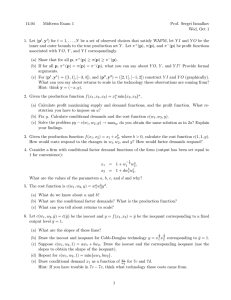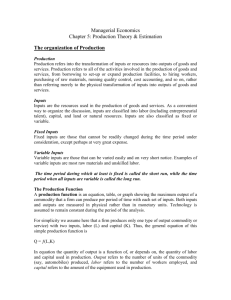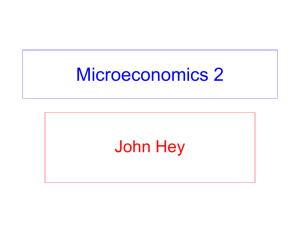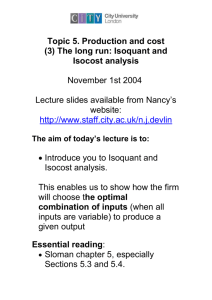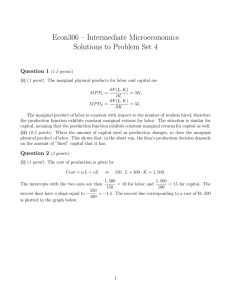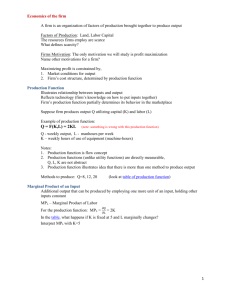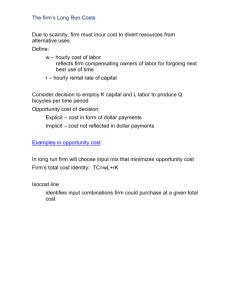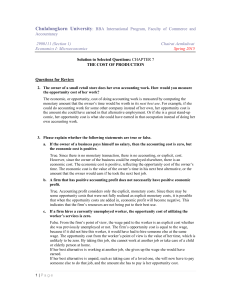Theory of Production
advertisement
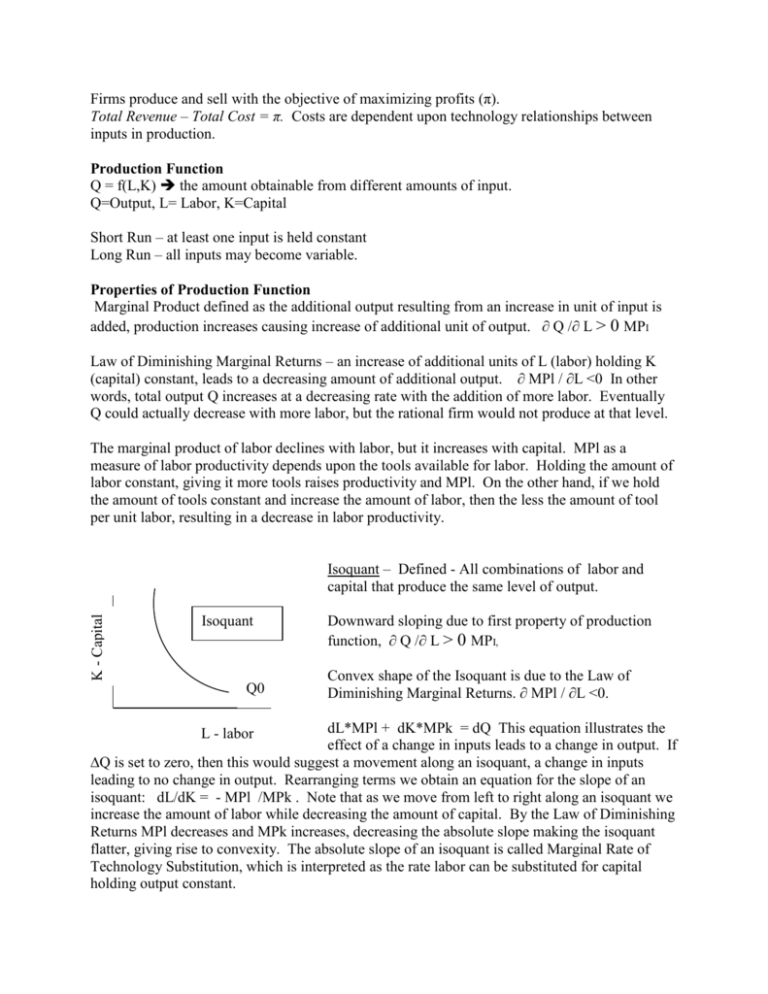
Firms produce and sell with the objective of maximizing profits (π). Total Revenue – Total Cost = π. Costs are dependent upon technology relationships between inputs in production. Production Function Q = f(L,K) the amount obtainable from different amounts of input. Q=Output, L= Labor, K=Capital Short Run – at least one input is held constant Long Run – all inputs may become variable. Properties of Production Function Marginal Product defined as the additional output resulting from an increase in unit of input is added, production increases causing increase of additional unit of output. ∂ Q /∂ L > 0 MPI Law of Diminishing Marginal Returns – an increase of additional units of L (labor) holding K (capital) constant, leads to a decreasing amount of additional output. ∂ MPl / ∂L <0 In other words, total output Q increases at a decreasing rate with the addition of more labor. Eventually Q could actually decrease with more labor, but the rational firm would not produce at that level. The marginal product of labor declines with labor, but it increases with capital. MPl as a measure of labor productivity depends upon the tools available for labor. Holding the amount of labor constant, giving it more tools raises productivity and MPl. On the other hand, if we hold the amount of tools constant and increase the amount of labor, then the less the amount of tool per unit labor, resulting in a decrease in labor productivity. K - Capital Isoquant – Defined - All combinations of labor and capital that produce the same level of output. Isoquant Q0 Downward sloping due to first property of production function, ∂ Q /∂ L > 0 MPI, Convex shape of the Isoquant is due to the Law of Diminishing Marginal Returns. ∂ MPl / ∂L <0. dL*MPl + dK*MPk = dQ This equation illustrates the effect of a change in inputs leads to a change in output. If ∆Q is set to zero, then this would suggest a movement along an isoquant, a change in inputs leading to no change in output. Rearranging terms we obtain an equation for the slope of an isoquant: dL/dK = - MPl /MPk . Note that as we move from left to right along an isoquant we increase the amount of labor while decreasing the amount of capital. By the Law of Diminishing Returns MPl decreases and MPk increases, decreasing the absolute slope making the isoquant flatter, giving rise to convexity. The absolute slope of an isoquant is called Marginal Rate of Technology Substitution, which is interpreted as the rate labor can be substituted for capital holding output constant. L - labor . Long Run Properties of Production: 2*K1 K - Capital Returns to Scale K1 Q1 Q0 L1 2*L1 L - labor In the diagram to the left we double the amount of inputs from L1, K1 to 2*L1 and 2*K1. Comparing the different levels of output as measured by the two isoquants, Q1 and Q2, defines the following: Increasing Returns Q1 >2Q 0 Doubling inputs more than doubles output Decreasing Returns Q1<2Q 0 Doubling inputs provides less than double the output Constant Returns Q1=2Q 0 Doubling inputs doubles the output *Assume Homogeniety- Slopes of Isoquants along a capital labor ratio are the same. Curvature of all isoquants is the same. K - Capital K/L Q1 MRTS is the same along a given K/L Ratio, which allows the use of 1 isoquant for representative purposes. Family of isoquants is a map for technology. Q0 L - labor Profit maximization requires Cost Minimization Isocost Line - all combinations of L and K which cost the same. Isocost derived from total cost function. Total Cost = (w * L) + (r * K); where w=wage rate, L=Labor, r=rental rate K=capital. Rewriting this in terms of the variable K allows us to plot into our input space diagram, K= (TC/r) – (w/r) L. This is the isocost curve whose properties are: the further from the origin (out to the North East) the greater the total cost, and w/r, its slope in the wage rental ratio, or the relative price of labor in terms of capital. With regards to the latter, the steeper the isocost the more expensive labor is relative to capital. Of course the converse also holds, the flatter the cheaper labor is relative to capital. K - Capital The closer the isocost line is to the origin, the lower the Total Cost, e.g., TC0< TC1, note they have the same slope (w/r). Comparing TC2 with either TC0 or TC1 note TC2 is steeper thus illustrates a relatively higher cost of capital. TC1 K - Capital TC2 TC0 K* Cost Minimization The rationale in cost minimization is straightforward. If cost can be lowered then L - labor profits can be increased. Thus one condition to maximize profits is to minimize costs. With regards to our analysis that would mean choosing the combination of labor and capital that costs the least to produce a given amount of output. For a given amount of output suggests that we are restricted to a single isoquant. Finding the least cost combination of labor and capital would mean we need to be on the lowest feasible isocost. That occurs at the tangency between isocost and isoquant as in the diagram. L* and K* are the lowest cost combination of L and K on Q0 given the wage rental rate depicted as the slope of the isocost. Q0 L* L - labor The least cost input bundle lies on the isocost line tangent to the Isoquant. In other words the slopes of the two are equal: -MPL/MPK = -w/r. Cross multiplying leads to MPL/w = MPK/r, which is interpreted as that the output per $ spent is equal across all inputs. If this were not the case then the firm could substitute the cheaper input for the more expensive and thus lower costs. How the firm responds to a change in input price. A change in the price of an input, either labor or capital, will change the wage rental ratio and consequently change the slope of the isocost curve. For example, if wages decrease, the isocost line becomes flatter. Now the cost minimizing firm will need to seek a new set of inputs as a K2 K1 K - capital result of the price change. Seeking the new tangency between the isoquant and the new isocost the firm will substitute labor for capital until their slopes are equal moving from L1, K1 down and to the right to L2, K2. w(1)/r Q0 w(2)/r L1 L2 L - labor
